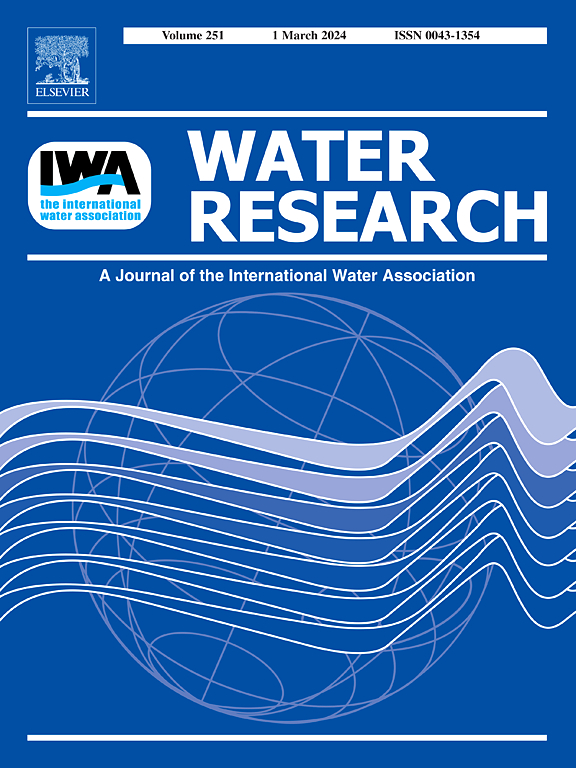Evaluating the generalizability and transferability of acoustic leak detection models for water distribution networks
IF 12.4
1区 环境科学与生态学
Q1 ENGINEERING, ENVIRONMENTAL
引用次数: 0
Abstract
Acoustic Leak Detection (ALD) plays a pivotal role in ensuring the operational safety of water distribution networks (WDNs). However, the cross-domain deployment of single-scenario ALD models is significantly hindered by environmental heterogeneity (pipe materials and diameters, etc.) and data scarcity in practical WDNs. This study presents the first systematic investigation into the generalizability and transferability of ALD models across multi-source WDNs through comprehensive cross-domain evaluation. The results show that: (1) The global model trained on the multi-region WDNs exhibits better generalization ability with an average accuracy improvement of about 2% compared to the local model. (2) Fine Tuning strategy achieves high transfer performance (96.8% and 96.2% accuracy for cross-material and cross-diameter scenarios respectively), outperforming Direct Transfer and Feature Extraction methods. (3) Transfer asymmetry is related to the distribution of input data under different conditions, where metal-to-nonmetal and large-to-small diameter transfers exhibit enhanced adaptability through broader source-domain frequency coverage. (4) Target-domain data requirements with the Fine Tuning strategy can be reduced by 50% while maintaining superior accuracy compared to source-domain local models. These findings advance AI-driven ALD techniques from a single-scenario-specific perspective to more mature applications of multi-scenario-universal.

评价配水管网声学泄漏检测模型的通用性和可移植性
声学泄漏检测在供水管网安全运行中起着至关重要的作用。然而,单场景ALD模型的跨域部署受到实际wdn中环境异质性(管道材料和直径等)和数据稀缺性的严重阻碍。本研究通过全面的跨域评估,首次系统地研究了ALD模型在多源wdn中的推广性和可移植性。结果表明:(1)与局部模型相比,基于多区域wdn训练的全局模型具有更好的泛化能力,平均精度提高约2%。(2)微调策略具有较高的传递性能(跨材料和跨直径场景的传递准确率分别为96.8%和96.2%),优于直接传递和特征提取方法。(3)传输不对称与输入数据在不同条件下的分布有关,其中金属到非金属和大到小直径的传输通过更宽的源域频率覆盖表现出更强的适应性。(4)与源域局部模型相比,采用微调策略的目标域数据需求可以减少50%,同时保持更高的精度。这些发现将人工智能驱动的ALD技术从单一场景特定的角度推进到多场景通用的更成熟的应用。
本文章由计算机程序翻译,如有差异,请以英文原文为准。
求助全文
约1分钟内获得全文
求助全文
来源期刊

Water Research
环境科学-工程:环境
CiteScore
20.80
自引率
9.40%
发文量
1307
审稿时长
38 days
期刊介绍:
Water Research, along with its open access companion journal Water Research X, serves as a platform for publishing original research papers covering various aspects of the science and technology related to the anthropogenic water cycle, water quality, and its management worldwide. The audience targeted by the journal comprises biologists, chemical engineers, chemists, civil engineers, environmental engineers, limnologists, and microbiologists. The scope of the journal include:
•Treatment processes for water and wastewaters (municipal, agricultural, industrial, and on-site treatment), including resource recovery and residuals management;
•Urban hydrology including sewer systems, stormwater management, and green infrastructure;
•Drinking water treatment and distribution;
•Potable and non-potable water reuse;
•Sanitation, public health, and risk assessment;
•Anaerobic digestion, solid and hazardous waste management, including source characterization and the effects and control of leachates and gaseous emissions;
•Contaminants (chemical, microbial, anthropogenic particles such as nanoparticles or microplastics) and related water quality sensing, monitoring, fate, and assessment;
•Anthropogenic impacts on inland, tidal, coastal and urban waters, focusing on surface and ground waters, and point and non-point sources of pollution;
•Environmental restoration, linked to surface water, groundwater and groundwater remediation;
•Analysis of the interfaces between sediments and water, and between water and atmosphere, focusing specifically on anthropogenic impacts;
•Mathematical modelling, systems analysis, machine learning, and beneficial use of big data related to the anthropogenic water cycle;
•Socio-economic, policy, and regulations studies.
 求助内容:
求助内容: 应助结果提醒方式:
应助结果提醒方式:


